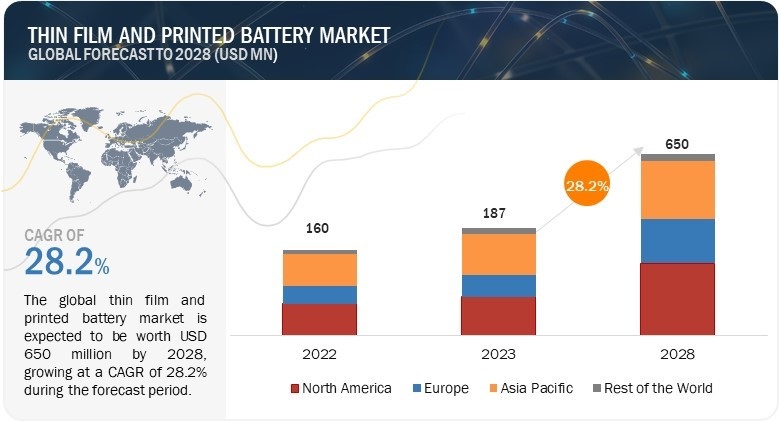The report “Thin Film and Printed Battery Market by Type (Thin Film, Printed), Voltage (Below 1.5 V, 1.5 to 3 V, Above 3 V), Capacity (Below 10 mAh, 10 to 100 mAh, Above 100 mAh), Battery Type (Primary, Secondary), Application, Region – Global Forecast to 2028″ highlights significant growth projections for the global thin film and printed battery market. Valued at USD 187 million in 2023, the market is forecasted to reach USD 650 million by 2028, reflecting a robust CAGR of 28.2% during the period.

Download PDF Brochure @ https://www.marketsandmarkets.com/pdfdownloadNew.asp?id=660
This rapid expansion is driven by the increasing adoption of compact and flexible energy storage solutions in various applications, including wearable devices, medical implants, and smart cards. The versatility and efficiency of thin film and printed batteries, coupled with advancements in technology and manufacturing processes, are propelling their integration into emerging markets and innovative product designs, further fueling market growth.
The miniaturization of electronic devices across various industries has significantly boosted the demand for thin film and printed batteries. These batteries, which offer a compact and flexible energy storage solution, are becoming increasingly popular due to their cost-effectiveness compared to conventional batteries. Emerging applications such as smart cards, medical devices, consumer electronics, and wireless sensors are driving this demand. The integration of thin film and printed batteries into these applications enhances device performance and longevity, supporting the ongoing trend towards smaller, more efficient, and versatile electronic products.
Inquire Before Buying @ https://www.marketsandmarkets.com/Enquiry_Before_BuyingNew.asp?id=660
The secondary battery segment is expected to gain a significant market share during the forecast period.
Secondary batteries, being rechargeable, can be charged repeatedly but are costlier than single-use batteries. Secondary thin film and printed batteries are recharged by depositing electrodes and electrolytes onto a flexible substrate, offering advantages such as flexibility, low cost, long cycle life, and safety. These batteries have a lesser environmental impact as they can be recycled instead of disposed of after each use. Lithium-ion (Li-ion) and lithium-ion polymer (Li-ion polymer) batteries, known for their high energy density, are the most commonly used rechargeable batteries. The adoption of wearable and medical devices, such as smartwatches and fitness bands, has surged in recent years, presenting a significant potential to drive the market for secondary thin film and printed batteries. Consequently, the secondary battery segment is poised to gain a substantial market share in the thin film and printed battery market.
The medical devices application is projected to gain a considerable market share during the forecast period.
Thin film and printed batteries represent promising new technologies with significant advantages for medical applications. Their flexibility and the ability to be printed on various substrates make them easy to manufacture and highly customizable to meet specific application needs. Currently, these batteries power implantable medical devices such as pacemakers, insulin pumps, and hearing aids. Additionally, they are used in wearable medical devices, including fitness trackers and blood pressure monitors. Overall, thin film and printed batteries offer numerous benefits for medical applications, and as the technology continues to advance, their usage is expected to expand into even more medical devices in the future.
Browse For More Details – https://www.marketsandmarkets.com/Market-Reports/printed-thin-film-battery-market-660.html
Asia Pacific is expected to hold a significant market share of the Thin Film and Printed Battery Market during the forecast period.
The Thin Film and Printed Battery Industry in the Asia Pacific is experiencing significant growth, fueled by the rising demand for IoT-enabled devices and portable consumer electronics in countries like China, Japan, and South Korea. The increasing popularity of next-generation smart cards in Asia is further driving this demand. The market is expected to expand considerably during the forecast period, driven by the surge in wearable devices and consumer electronics. Several startups in the region are actively developing and integrating thin film and printed batteries into various products. Additionally, companies are adopting new product launch strategies to strengthen their market presence, contributing to the robust growth of this market segment.
Thin Film and Printed Battery Companies:
- Samsung SDI Co., Ltd. (South Korea),
- Enfucell (Finland),
- Ultralife Corporation (US),
- Molex, LLC (US),
- NGK Insulators, Ltd. (Japan),
- Cymbet Corporation (US),
- Ilika plc (UK),
- Jenax Inc. (South Korea),
- ProLogium Technology Co., Ltd. (Taiwan),
- Renata SA (Switzerland),
- VARTA AG (Germany).
News Covered:
https://www.prnewswire.com/news-releases/thin-film-and-printed-battery-market-worth-650-million-by-2028—exclusive-report-by-marketsandmarkets-301868735.html

